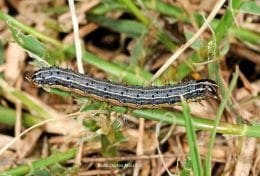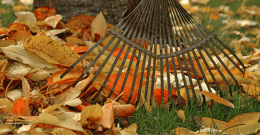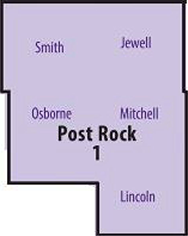This year we have seen numerous reports of fall armyworms. Though we have had fall armyworm outbreaks in the past, this is earlier than usual. Armyworms are so-called because they invade fields or landscapes as large groups and can cause a lawn to turn brown seemingly overnight.
Young worms are ½ to 3/4 inch long. Mature ones are 1 ½ inches long. Body color may vary from green to almost black but light stripes will be visible along the length of the body. Look for a whitish inverted “Y” on the top of the black head. It normally takes 2 to 3 weeks to progress from egg to pupa. The adult is a moth.

Armyworm damage can resemble drought damage but close inspection of the turf will reveal the larvae. Look for active feeding during early morning or evening hours or on cloudy days. Larvae feed on foliage and the resulting dehydration causes to turf to quickly brown. Normally, armyworm damage does not kill established turf but may if populations are high enough. Thick infestations of fall armyworm can damage turfgrass crowns which will kill turf.
Acephate (Orthene), spinosad (Conserve; Natural Guard Spinosad, Captain Jack’s Deadbug Brew; Monterey Garden Insect Spray) and other insecticides are effective caterpillar killers. Treat in late afternoon, when the caterpillars are likely to begin feeding. Do not mow for 3 days after treatment.
By: Cassie Homan


 One of my favorite parts of fall are the colorful mums that show up in greenhouses and garden centers. They bring a colorful pizzazz to the fall season. We often get asked if these plants will survive the winter. This short YouTube video will answer those questions.
One of my favorite parts of fall are the colorful mums that show up in greenhouses and garden centers. They bring a colorful pizzazz to the fall season. We often get asked if these plants will survive the winter. This short YouTube video will answer those questions.


